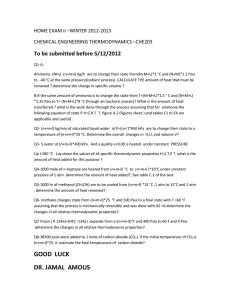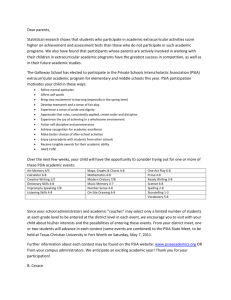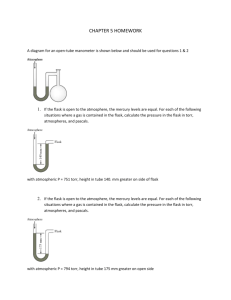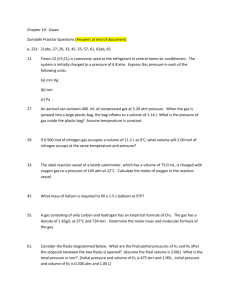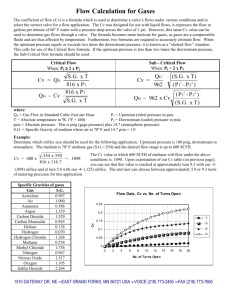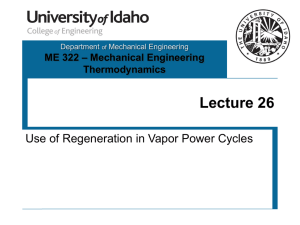Pressure Units - Sublimation Science
advertisement
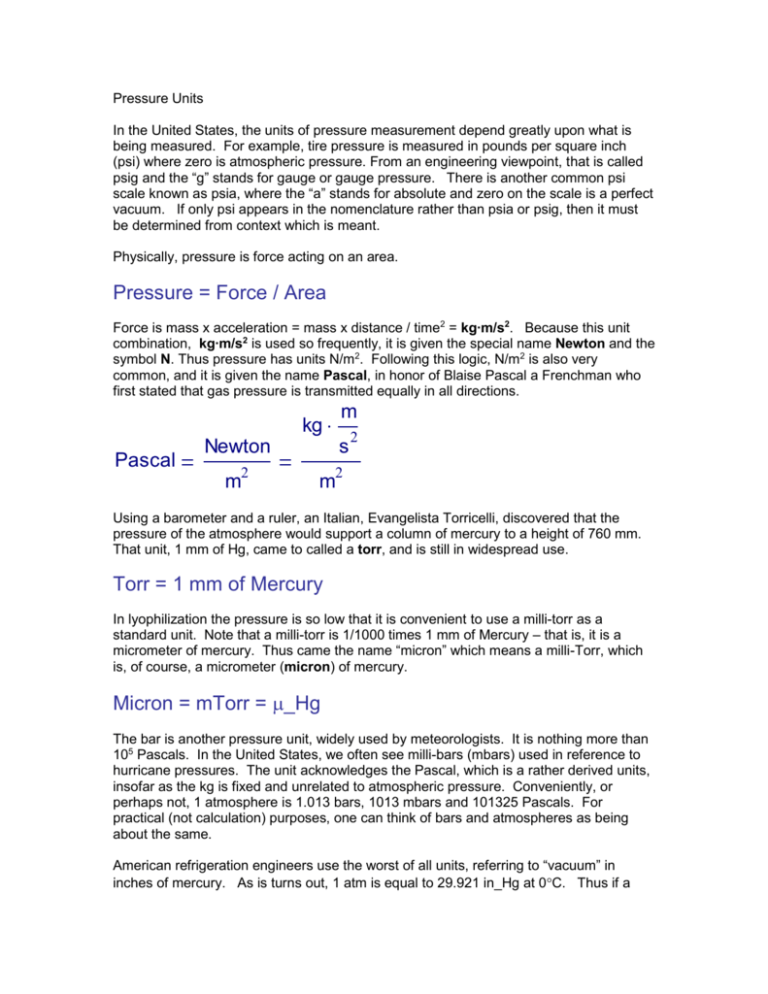
Pressure Units In the United States, the units of pressure measurement depend greatly upon what is being measured. For example, tire pressure is measured in pounds per square inch (psi) where zero is atmospheric pressure. From an engineering viewpoint, that is called psig and the “g” stands for gauge or gauge pressure. There is another common psi scale known as psia, where the “a” stands for absolute and zero on the scale is a perfect vacuum. If only psi appears in the nomenclature rather than psia or psig, then it must be determined from context which is meant. Physically, pressure is force acting on an area. Pressure = Force / Area Force is mass x acceleration = mass x distance / time2 = kg∙m/s2. Because this unit combination, kg∙m/s2 is used so frequently, it is given the special name Newton and the symbol N. Thus pressure has units N/m2. Following this logic, N/m2 is also very common, and it is given the name Pascal, in honor of Blaise Pascal a Frenchman who first stated that gas pressure is transmitted equally in all directions. m kg Pascal Newton 2 m s 2 2 m Using a barometer and a ruler, an Italian, Evangelista Torricelli, discovered that the pressure of the atmosphere would support a column of mercury to a height of 760 mm. That unit, 1 mm of Hg, came to called a torr, and is still in widespread use. Torr = 1 mm of Mercury In lyophilization the pressure is so low that it is convenient to use a milli-torr as a standard unit. Note that a milli-torr is 1/1000 times 1 mm of Mercury – that is, it is a micrometer of mercury. Thus came the name “micron” which means a milli-Torr, which is, of course, a micrometer (micron) of mercury. Micron = mTorr = _Hg The bar is another pressure unit, widely used by meteorologists. It is nothing more than 105 Pascals. In the United States, we often see milli-bars (mbars) used in reference to hurricane pressures. The unit acknowledges the Pascal, which is a rather derived units, insofar as the kg is fixed and unrelated to atmospheric pressure. Conveniently, or perhaps not, 1 atmosphere is 1.013 bars, 1013 mbars and 101325 Pascals. For practical (not calculation) purposes, one can think of bars and atmospheres as being about the same. American refrigeration engineers use the worst of all units, referring to “vacuum” in inches of mercury. As is turns out, 1 atm is equal to 29.921 in_Hg at 0C. Thus if a “vacuum” gauge is reading 18 in_Hg, its meaning is 29.921-18 = 11.921 psia. This unit is typically found on air conditioning manifolds. They compound the issue by measuring pressure above atmospheric in psig. Thus, a perfect vacuum is 29.921 in_Hg and 1 atm is “zero” and 2 atm is 14.696 psig. Conversion between units is easily done at scores of internet sites, or you can use the formula below. Pascal Bar mbar Atm Torr mTorr PSIA In_Hg Pascal 1 N/m2 100,000 100 101,325 133.322 0.13322 6894.757 3386.38 Bar 10-5 1 dyne/cm2 .001 1.01325 0.00133322 1.333 x 10-6 0.068948 0.033864 mBar 0.010000 1000 1 1013.25 1.333 1.333 x 10-6 68.948 33.864 Atm 9.869 x 10-6 0.986923 986.9 x 10-6 1 atm 0.00131579 1.315 x 10-6 0.068046 0.033421 Torr 0.00750062 750.061683 0.75006 760 1 mm Hg .001 51.714933 25.399939 mTorr 7.500617 750061.683 750.062 760000. 1000 1 51714.933 25399.939 PSIA 145.03774 x 10-6 14.503774 0.014504 14.695949 0.01933677 19.337 x 10-6 1 lb/in2 0.491153 In_Hg 295.3006 x 10-6 29.530059 0.029530 29.921332 0.03937017 39.37 x 10-6 2.036026 1 in Hg To use this conversion table: 1. Find the “from” unit in Column 1. 2. Find the “to” unit in Row 1 (across the top) 3. Use the crossing value as a multiplier. “From Units” x Multiplier = “To Units” FYI: The units for each multiplier are (Row Name) / (Column Name) Example: Convert 150 mTorr to PSIA. Step 1: 150mTorr is 0.15 Torr Step 2: Finding Torr on the left column and PSIA on top, the multiplier is 0.01933677. Step 3: 0.15 Torr x 0.01933677 PSIA / Torr = 0.0029 psia. In summary, Pascals and Bar are derived units from the kilogram. PSIA is a derived unit based on the pound. Torr and In_Hg are units based on the height of a mercury column in a barometer. Atmospheres is a fraction of the pressure exerted (on average at zero deg C) at sea level by the air, using 1 atm as that pressure.
